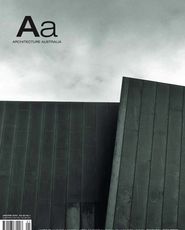Lifting architecture to a level of national pride and national importance is the challenge facing the profession and the RAIA over the next few years. This possibility seems more real now given that the new agenda of state and territory government leaders to include statements about quality architecture and urban design. The dialogue in just the past few weeks has been astounding; the Western Australian Cabinet extensively briefed on quality architecture and architects by the WA Chapter President Warren Kerr; Queensland Hansard recording ebullient statements of support and declarations of the importance for quality architecture; Premier Bob Carr at a recent Mirvac luncheon in Sydney for financiers, property developers and contractors, declaring that quality architecture, including a mention of the RAIA, was one of the most important objectives of the city and his government. The echo of similar declarations can be heard in other places too.
Within this ferment, it is becoming increasingly potent that the Federal Government find a positive way to become engaged in the debate on lifting the quality and stature of architecture.
Unfortunately, as with the US Constitution, the Australian Constitution effectively excludes the built environment from federal responsibilities. Although the Keating Government pursued urban design initiatives through targeted budgetary allocation with the Better Cities Program, little has happened since. Gough Whitlam commented to me recently that the only way that the Federal Government was able to elevate residual state and territory interests to the national agenda was through the signing of international treaties which created national responsibilities. Intellectual property and racial discrimination are but two examples of international treaties at work.
A number of countries have adopted Policies on Architecture. In France, and more lately across the whole European Union, architecture has been officially decreed as being of public interest’. Increasingly, quality in architecture and quality in architectural services are seen to provide real and lasting benefits to the public. It not only provides tangible utility but creates a cultural resource, the characteristics of which can be both fundamental and intangible.
Our vision for 2004 and beyond, and set in place in 2003, must be to elevate architecture to the national political agenda. A Political Action Plan which can enable the profession, through the institute, to create debate, discussion, appreciation, opportunities and platforms for exploring the public dimension of architecture and its cultural value is a vital first step. Such an action plan could be the basis for programs if 2004 is declared the Year of the Built Environment as is currently proposed by the RAIA, BDP and ACIF to the Federal Cabinet. If not, it must still be pursued, albeit with more limited means at our disposal but with the same level of vigour.
I would like to invite you to be a part of this process at the RAIA 2003 National Conference Imagining Architecture’’ in Sydney in late May.
Creative Director Ian Moore is crafting an event that will both captivate and provoke.
Graham Jahn FRAIA
RAIA National President















